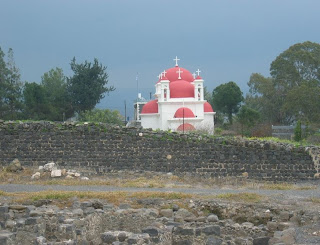Click on photo to enlarge it
This beautiful Greek Orthodox Church was built in the ruins of the village Kfar-Nahum (Capernaum - Village of Nahum) in 1931. The area surrounding it has not been excavated like the ancient synagogue and the structures around it. The authority over the ruins is divided, and the Orthodox church controls about a third of the approximately fifteen acre site.
Click on photo to enlarge it
Click on photo to enlarge it
The church is known by a couple of names: The Church of the Seven Apostles (represented by the seven crosses on the domes of the church remembering the seven apostles chosen by Christ in the immediate area), and The Church of the Twelve Apostles (remembering all the apostles chosen in the general area).
Because Capernaum didn’t participate in the two major Jewish revolts against Rome, it was virtually untouched when they came to Israel and crushed the rebellion. However, nature would take its course. Capernaum was severely damaged by the Golan Earthquake on January 18, 749 AD. Although some of it was rebuilt, it never was a major city again, and was abandoned sometime in the 11th century.
Jesus predicted this abandonment when He said of Capernaum, Chorazin, and Bethsaida: Then Jesus began to denounce the cities in which most of his miracles had been performed, because they did not repent. 21 “Woe to you, Korazin! Woe to you, Bethsaida! If the miracles that were performed in you had been performed in Tyre and Sidon, they would have repented long ago in sackcloth and ashes. 22 But I tell you, it will be more bearable for Tyre and Sidon on the day of judgment than for you. 23 And you, Capernaum, will you be lifted up to the skies? No, you will go down to the depths. If the miracles that were performed in you had been performed in Sodom, it would have remained to this day. 24 But I tell you that it will be more bearable for Sodom on the day of judgment than for you.” Matthew 7:20-24



Comments
Post a Comment